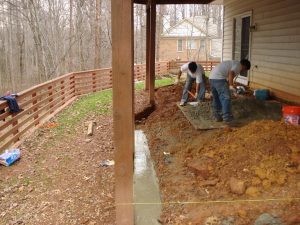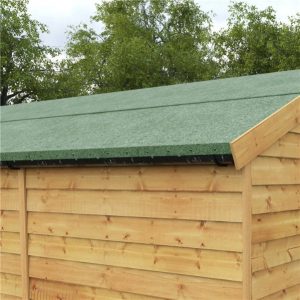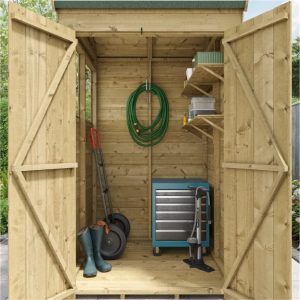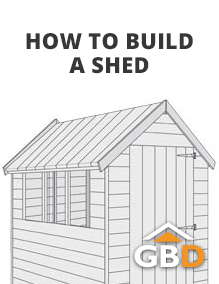Building a shed yourself might cost a bit less than buying one, and you can tailor it according to your needs. What’s more, you can work at your own pace and have complete control over the project. If you’re doing it for the first time, feel free to follow this guide for step-by-step directions.
Step 1: Prepare the area
Your first step in how to build a shed is to ready the ground. Once you have the measurements of your shed, mark the outlines where the structure will be placed. Since this is a DIY project, the dimensions of your shed can be whatever you like.
Mark the outlines of each corner with stakes, then tie them with string to create a perimeter. Although using a tape measure is optional, this tool can provide accuracy for the distances, so feel free to use one.
Note: Ideally, the shed’s location should be on flat ground away from wet or muddy soil to ensure its stability once installed.
Step 2: Build the foundation

A solid foundation is non-negotiable if you want your structure to stand tall and maintain its durability for years. While there are various methods for shed base construction, we’ll stick to the easiest option: concrete piles.
For reference, this is for a 2 x 2m shed. Measure and mark positions for 9 foundation piles, each 40x40cm and 1m apart. Dig each hole to a depth of 70 cm using a spade. In sandy soils, you may have to use wooden formwork to create square holes.
To prepare floor joists, saw 3 floor joists to a length of 1.9 metres from 50×150 mm timber beams. Mount 3 ground anchors to each joint, centred in the holes. Next, use wooden blocks to rest the floor joists; anchor posts must be hung in the centre of the holes.
Pour concrete into the holes up to 1 cm below the joists and let it harden. The wooden block will hold the joists in position, so keep them in place during the curing process. Once the concrete is dry, the two outer crossbeams will be saw and installed at 2 m, and the centre support pieces will be 92.5 cm.
Spread a layer of small, coarse gravel or crushed stone within the squares to add stability to the foundation.
Step 3: Install flooring
Your next step in building a shed storage is laying the floor, and it should be straightforward. Lay the first board across three joists with the tongue facing into the shed, then fasten it with screws. Then, fit the second board’s grooves onto the first tongue, secure, and continue doing so until the entire floor is covered. Trim any excess from the tongue of the last board once finished.
Step 4: Assemble and install the walls
Pre-assembling the wall panels of a wooden shed before installing them one by one onto the shed base can be much easier. First, lay out the bottom and top plates for each wall section. Ask a friend for help if handling this alone is too challenging.
Attach vertical studs between the plates at regular intervals, and secure each with nails or screws. Proceed to install headers above any door or window openings as needed. Then, raise each wall section to a position on the shed base, and fasten it. Make adjustments as necessary before moving on to the next wall section.
Make sure that your wall panels include openings for doors and windows.
Step 5: Work on the roof beams
Using the same 2 x 2 m shed size as a reference, cut five rafters from the 150 x 150mm timber for the roof. Trim each bean to 2430 mm length with ends angled at 30° and 60°.
Next, create notches or grooves in the wood to connect the roof beams with the wall joists. These notches should align where the roof beams meet the vertical posts of the wall frames, about 20.4 cm to 28 cm from each end. Each notch should measure 76 mm in length and 1.5 cm in depth. Lastly, secure the rafters to the support posts using 6 x 150 mm screws.
Note: All measurements are provided as a guide. You can follow these if you’re building a 2 x 2 m shed. If not, keep in mind that the numbers may vary depending on the actual size or dimensions of your DIY shed.
Step 6: Mount the roof battens and panel
You’re still working on the roof structure, but these parts are necessary support for your roof covering. Secure 8 battens, each cut to 438 mm in length from the same timber, between the rafters perpendicular to them. Aim to make the top face of the battens flush with the top of the rafters to create a smooth and even surface. Once the battens are in place, attach the OSB roof panel to create a sturdy base for your roofing material.
Step 7: Clad the exterior
Before you install the roof covering material, fix the tongue and groove panelling to give the roof structure a polished finish. These additions not only improve the appearance of your shed but also provide added wind and weather resistance.
Install the panels vertically for proper drainage, preventing moisture buildup between the boards. Use screws or nails to secure the panelling to the framework.
Step 8: Install the roof covering

Your choice of roof covering is up to you, but you’ll want to choose a durable material for maximum protection. Your best options include shed roofing shingles, green mineral felt, and metal panels.
For roofing felt, lay it over the OSB roof panel to get that additional waterproof layer, and then secure. If using shingles, start from the bottom edge of the roof and work your way up, overlapping each row. But if you decide to use metal panels, align them with the roof edge and fasten them down with screws.
Use roofing adhesive or sealant as needed to guarantee all edges and corners are well sealed.
Step 9: Mount doors and windows

Position each door and window frame in its designated opening according to your planned shed layout. Fasten them with screws or nails, and consider adding sealants to prevent drafts from sneaking inside.
Adjust the hinges on the doors until you are satisfied with their performance. Weatherstripping around the edges is effective for adding insulation and water resistance. Install a reliable and quality shed lock for security.
Seal the windows around the edges with silicone caulk. Consider adding window screens for ventilation and insect control. Refer to our guide, ‘How to Keep Insects Out Your Summerhouse,’ for more ideas.
Step 10: Finishing touches

9 steps later, your DIY shed is up and almost ready for use! If you’re using it mainly for storage, install rows of shelving units to maximise the space inside. Hooks and pegboards are great for hanging tools, such as your go-to gardening tools.
Make it accessible even at night with indoor lighting, so you won’t have to use a flashlight when searching for a certain item. Paint the walls in white for a clean look and to brighten up the interior. If there are windows, consider hanging curtains for privacy or protection from harsh sunlight if needed.
Decorate the shed according to its intended purpose and add any necessary items. And voila, you’ve just built a functional garden room!
The general process of how to assemble a shed can vary depending on your specific requirements, but the steps above can serve as helpful guidelines. Once you’ve completed this project, check out these ‘Unique Ways to Use a Shed Interior’ for creative ideas on how to utilise the space.

